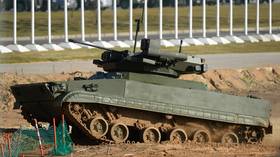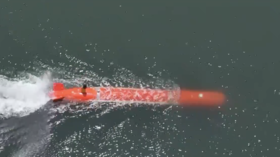Russia’s fully autonomous UDAR Unmanned Combat Ground Vehicle can talk to drones & is capable of revolutionizing battlefield

Russia's military may soon have a new state of-the-art Unmanned Combat Ground Vehicle for use in combat, surveillance and reconnaissance, as well as for providing vital engineering and logistics support to troops in the field.
The operational prototype has been created by the Signal All-Russian Scientific and Research Institute, part of the country’s state-owned defense and tech corporation Rostec.
Rostec Combat Systems Production Director Bekkhan Ozdoyev said, “Our goal was to make the Udar a fully autonomous vehicle. It’s equipped with an AI that collects data through a system of sensors and measuring devices, then processes it to generate optimal routes for the terrain it’s running through. The system can also calculate optimal parameters for performing combat assignments on site."
Also on rt.com Russian Navy joins major multinational AMAN-2021 drills in Pakistan, NATO countries also expected to attend (VIDEO)The Signal group focuses on developing AI solutions for existing models of Russian combat systems, with the Udar UCGV essentially being a high-tech upgrade of the BMP-3 infantry fighting vehicle (IFV) that has shown a great performance record over the past few decades.
The UCGV was previewed in 2015 at the Russian Ministry of Defense-sponsored Innovations Show. Ozdoyev added that the new UCGV can “interact with and carry unmanned aerial vehicles, including tethered drones powered by the vehicle, to be used for reconnaissance and data relay.”
Designed for combat, surveillance and reconnaissance, as well as engineering and logistics support, the Udar is based on the BMP-3 armored vehicle chassis, carries a multicopter drone and comes with a mobile control unit based on the Ural 4320 chassis.
The Udar system is equipped with both classic and advanced weapons. It combines a 2A42 30mm automatic cannon with an effective firing range of 4,000m and Kornet anti-tank guided missiles with a range of up to 10,000m into a single Bumerang-BM turret, ensuring it hits its target even in the most challenging conditions.
The 2A42 30mm automatic cannon has 500 rounds stored in an isolated section, meaning the platform would remain intact even if the weapons module were damaged. The Udar is also equipped with a coaxial PKT machine firing 2,000 rounds.
Next-generation electro-optical equipment combined with a state-of-the-art fire control system allows the UCGV to simultaneously track multiple targets in different lighting conditions both actively and passively, helping it root out even camouflaged objects.
Developers describe the Udar system as a multi-purpose robotic platform that can be outfitted with different types of equipment or weapons, depending on tactical objectives. The plan is to build three classes of vehicle: for combat and reconnaissance, field engineer support, and transportation/evacuation.
The attack and reconnaissance robot will be able to fire its weapons and mark targets for aviation and artillery, as well as other robotic systems. The Udar engineer-support vehicle will include various machines for sifting through debris and clearing rubble, while its multi-positional manipulator will work with explosives. The robot can also be used to transport cargo, personnel and – most importantly – evacuate the wounded from the battlefield.
Also on rt.com ‘Stop your saber rattling!’ Russia tells US to sail its warships in its own waters, and not jeopardize peace in far-away Black SeaBeing fully autonomous, the Udar is able to move in complete radio silence, meaning that the crew operating it will not receive any data from the vehicle and will not be required to transmit any radio signals to pilot it. This allows automation of certain routine activities, such as cargo transportation. The first time the vehicle completes a route, it memorizes it and can then shuttle between the destinations on its own.
Still, some experts note that the BMP-3 chassis on which it is based is not well-protected enough against enemy weapons systems for it to be considered ‘invulnerable’. The frontal armor can only withstand 30mm rounds fired from a distance of 200 meters and the roof and the sides can withstand a 12.7mm B-32 bullet from a distance of 100 to 200 meters. But exposing BMP-3s to enemy tank guns and anti-tank guided missiles would be suicide, as its primary use was to transport infantry to the battlefield, not engage in combat with well-armored enemy fighting vehicles.
Like this story? Share it with a friend!














